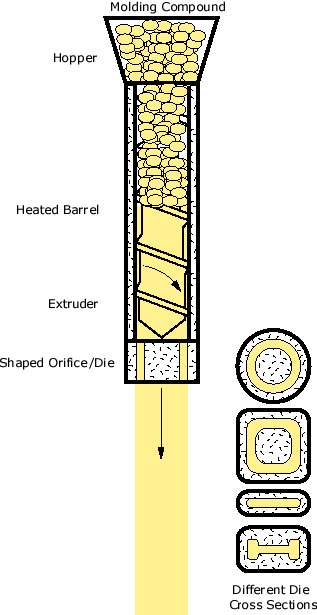Introduction to Extrusion Molding
Extrusion is one of the most widely used manufacturing processes across many industries. Essentially, it is not much different from squeezing tooth paste out of the tube. Anything that is long with a consistent cross section is probably made by extrusion. Common examples are spaghetti, candy canes, chewing gums, drinking straws, plumbing pipes, door insulation seals, optical fibers, and steel or aluminum I-beams.
The plastic extrusion molding process usually begins with a thermoplastic in the form of pellets or granules. They are usually stored in a hopper (a funnel-shaped receptacle) before they are delivered to a heated barrel. The molten plastic is then forced through a shaped orifice, usually a custom steel die with shape of the cross section of the intended part, forming a tube-like or rod-like continuous workpiece. Cooling of the workpiece should be as even as possible.

Extrusion molding maintains a constant cross-section to keep the cost down in almost all cases. Most thermoplastics can be used for extrusion. However, materials with higher stiffness and/or strength in the molten state are usually preferred since they are easier to form and maintain the desired shape. Other considerations regarding material selection may include heat and UV stability (for longevity), flame and chemical resistance (for safety), and strength and flexibility (for utility). Common plastics used in extrusion molding processes are
◾Acrylonitrile Butadiene Styrene (ABS)
◾Acrylic
◾Polycarbonate (PC)
◾Polyethylene (PE)
◾Polypropylene (PP)
◾Polyester
◾Polystyrene (PS)
◾Polyvinylchloride (PVC)
When designing an extruded part, it is advisable to keep the wall thickness as uniform as possible. One should also try to avoid sharp corners to reduce chipping and warping.
Pros and Cons of Extrusion Molding
Pros ◾Low initial setup costs
◾Fast setup time
◾Low production costs
Cons ◾Moderate production speed
◾Mediocre precision
◾Limited to parts with a uniform cross section

